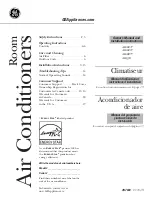
18
GB
The following do not indicate any malfunction:
Odours: smells such as tobacco or cosmetic odours may persist after they have
been sucked into the unit.
Sound of liquid flowing inside indoor unit: this can occur during or after operation
and is simply the sound of refrigerant being circulated inside the unit.
Ticking sound coming from indoor unit: this can occur when cooling has just
begun or has just stopped. It is caused by the indoor unit shrinking or expanding
slightly due to the change in temperature.
NOTE: The refrigerant charged in the air conditioner is safe. Refrigerant
normally does not leak, however, if refrigerant gas leaks indoors,
and comes into contact with the fire of a fan heater, space heater,
stove, etc., harmful substances will be generated.
Be sure to ask the service representative whether there is
refrigerant leakage or not when repairs are carried out.
7. Installation, Transferring Works, and Checking
Regarding place for installation
Consult with your dealer for details on installation and transferring the installation.
Caution:
Never install the unit where there is a risk of leakage of flammable gas.
If gas leaks and accumulates around the unit, fire can result.
Never install the unit at the following place:
• where there is a lot of machine oil
• near the ocean and beach areas where there is salt air.
• where humidity is high
• where there are hot springs nearby
• where there is sulphurous gas
• where there is a high-frequency processing machinery (a high-frequency
welder, etc.)
• where acid solution is frequently used
• where special sprays are frequently used
• Install the indoor unit horizontally. Otherwise, water leakage can result.
• Take sufficient measures against noise when installing the units at hospitals or
communication-related businesses.
If the unit is used in any of the above-mentioned environments, frequent
operational failure can be expected. It is advisable to avoid these types of
installation sites.
For further details, consult with your dealer.
Regarding electrical work
Caution:
• The electrical work must be undertaken by an authorized electrician
according to the local regulation, and the installation instruction manual
with the absolute use of exclusive circuits. The use of other products
with the power source can result in burnt-out breakers and fuses.
• Never connect the grounding wire to a gas pipe, water pipe, arrester, or
telephone grounding wire. For details, consult with your dealer.
• In some types of installation sites, the installation of an earth leakage
breaker is mandatory. For details, consult with your dealer.
Regarding transfer of installation
• When removing and reinstalling the unit when you enlarge your home, remodel,
or move, consult with your dealer in advance to ascertain the cost of the
professional engineering work required for transferring the installation.
Caution:
When moving or reinstalling the unit, consult with your dealer. Defective
installation can result in electric shock, fire, etc.
Regarding noise
• In installing work, choose a place that can fully bear the weight of the unit, and
where noise and vibration can be reduced.
• Choose a place where cool or warm air and noise from the outdoor air outlet of
the unit does not inconvenience the neighbors.
• If any alien object is placed near the outdoor air outlet of the unit, decreased
performance and increased noise can result. Avoid placing any obstacles
adjacent to the air outlet.
• If the unit produces any abnormal sound, consult with your dealer.
Maintenance and inspection
• If the unit is used throughout several seasons, the insides can get dirty,
reducing the performance.
Depending upon the conditions of usage, foul odors can be generated and
drainage can deteriorate due to dust and dirt, etc.
8. Cleaning the Panels
Wipe the panels using a soft cloth dampened with mild detergent, and then wipe off all detergent with a dry cloth.
Do not use benzine or thinners.
9. Checking V Belts
As the operation time passes, the total length the V belt of the indoor unit fan stretches and tension decreases. Continuing operation in such a state may cause uneven
wear and make abnormal noise, and cause a failure. For details on, for example, V pulley adjustment, consult the dealer.
[Adjustment Interval]
• Initial time: After 24 to 28 hours
• From second time: Every 2,000 hours
• Replacement: Every 5,000 hours
00gb_WT05475X02_7.book Page 18 Tuesday, June 16, 2009 12:33 PM




































